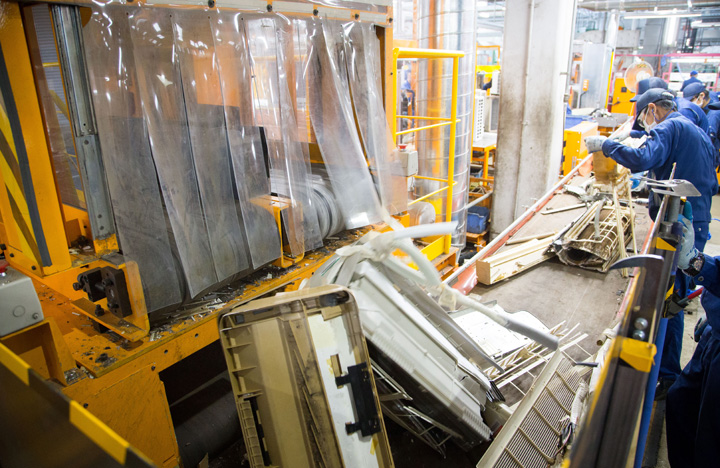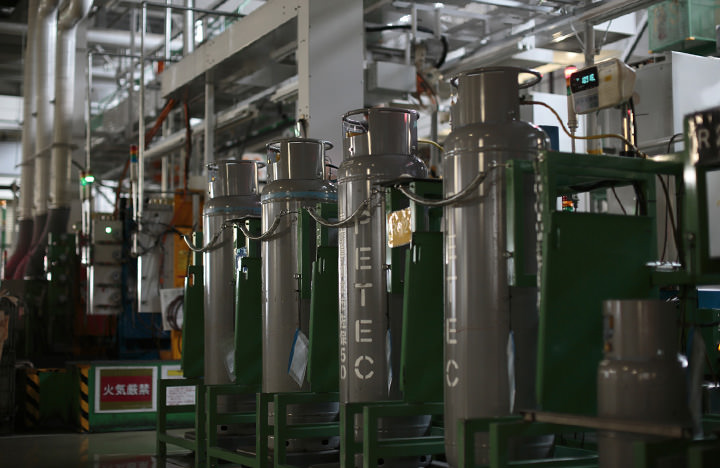PETEC takes advantage of the vast knowledge that it gains from its everyday activities to also develop and apply advanced recycling technologies.
Development and Practical Application with an Eye to the Future
Panasonic promotes "recycling-oriented manufacturing," which repeats the use of the limited amount of resources on Earth. As a part of this initiative, we are working to enhance the use of recycled resources.
The Panasonic Eco Technology Center (PETEC) has an in-house R&D division in its facility, which works hand-in-hand with the many R&D teams of the Panasonic Group. Based on knowledge gained from actual recycling work, these R&D professionals strive to discover new recycling methods and systems, focusing on technologies for efficiently recovering and reusing the valuable resources that remain in end-of-life appliances.

Recycling Technology Developed to Sort Three Types of Plastic Simultaneously
- • Improvements were made to a high-precision resin selection system using near-infrared identification technology that was developed by Panasonic in 2010, to develop a new technology for sorting and recovering three types of resins (PP, PS, ABS) simultaneously.
- • The resins are processed three times faster than with conventional methods, and recovered with a level of precision that exceeds 99% purity.
- • This technical development will accelerate the reuse of recycled resins.
Press release:
Panasonic Develops Recycling Technology That Simultaneously Sorts Three Types of Resin (Only available in Japanese)

Inside the High-Precision Plastic Sorting System

Three types of resin (PP, PS and ABS) are simultaneously sorted with high precision.

Sorted and recovered by material type...

Each is shipped as a single recycled resin.
High-efficiency recycle line dismantles air conditioners while considering the work load.
- • An automated transport system safely conveys products to the line.
- • The indoor units, which were previously dismantled by hand, have the ends cut by a shearing machine for easy dismantling.
- • A special device is uses to convey heavy objects, reducing the burden on operators.

Indoor units, from which screws were previously removed by hand, are conveyed to a shearing machine.

The edges, where screws are concentrated, are cut, and the operator sorts the parts of the cut up indoor units.

On the 2nd floor, the parts of dismantled outdoor units are sent to the 1st floor recovery box by a shooter.

The work load of conveying heavy objects is reduced, and the objects are efficiently recovered and conveyed.
For details, please refer to "Recycling Processes: Recycling Air Conditioners."
A highly efficient recycling line that enables disassembly of unsorted refrigerators
- • Reads the item number of the end-of-life refrigerator, and automatically detects the type of refrigerant gas and insulating foamed gas.
- • A full mix can be treated regardless of the gas type (fluorocarbon/non-fluorocarbon).
- • Insulating foamed gas is safely treated by a special crusher for each gas type (fluorocarbon/non-fluorocarbon).

Gas types (fluorocarbon/non-fluorocarbon) are automatically distinguished and transported.

They are automatically inserted into the dedicated crusher. This enables safe, unmanned treatment.

The fluorocarbon refrigerant is recovered from end-of-life fluorocarbon-type refrigerators.

The recovered fluorocarbon is sent to special processing plants in a tightly sealed condition.
For details, please refer to "Recycling Processes: Recycling Refrigerators."
Development of a Highly Efficient Recycle Line That Enables In-Line Processing of Tilted Drum Washing Machines
- • In order to process the tilted drum washing machines that are expected to increase in the future, the line has been redesigned to allow in-line processing. This greatly improves the daily processing capability.

Washing machines with tilt-type drums and vertical drums are processed on the same line.

An efficient workflow is achieved by highly skilled staff members.

The recycling facilities respond flexibly to advancements in home appliances.
For details, please refer to "Recycling Processes: Recycling Washing Machines."
PETEC has many new technologies or processes, some of which were put to practical use for the first time in Japan. These technologies have been patented and widely opened to the public. Because of this, PETEC technologies are actively used in factories both inside and outside Japan.





























